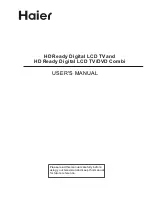
- 11 -
CONNECTIONS
CONNECTING A TV ANTENNA/CABLE/SATELLITE
To view television channels correctly, a signal must be received from one
of the following sources:
- An indoor or outdoor aerial antenna
- A cable system
- A satellite system
Note:
For receiving over-the-air TV broadcasts, we recommend that you use
an external fixed antenna. Should you require the use of a temporary
antenna, please ensure that you purchase an antenna with sufficient
ability to receive in weak signal areas. Only when you are in close
proximity to a transmitter will a temporary antenna reproduce a signal as
strongly as a fixed antenna.
CONNECTING A POWER CORD
• Connect the AC power cord into a wall outlet.
• Press the / I button on the unit or remote control to turn on the unit.
Note:
• Be sure the AC power cord is disconnected and the
TV is switched off before making connections.
• Make sure that all the components are connected
correctly.
• When you are not going to use the unit for a long
period of time, disconnect the power cord.
• The apparatus should not be exposed to dripping or
splashing and that no objects filled with liquids, such
as vases, should be placed on apparatus.
• The mains plug is used as the disconnecting device.
It should remain readily accessible and should
not be obstructed during use. To be completely
disconnected from the supply mains, the mains plug
of the apparatus should be disconnected from the mains socket outlet completely.
COMMON INTERfACE
The unit is equipped with a CI slot. The CI slot allows you to insert a CAM (Conditional Access Module) with an
appropriate subscription card for some pay for view services.
It is required to subscribe to a pay channel company to view the pay channels of the Digital Terrestrial
broadcasting.
Fully insert the CAM (Conditional Access Module) into the CI (Common Interface) slot on the bottom of the unit
with its label side facing you.
Satellite, Cable, or TV
antenna
cable
to
TV
ANTENNA CABLE Terminal
(cable not included)
Important notes:
• Switch off the TV and unplug from the AC power mains before insert or remove the CAM.
• The CAM should be correctly inserted, it is impossible to insert fully if reversed. The CAM or the TV
terminal may be damaged if the CAM is forcefully inserted.
• Some CAMs may require setting up. Refer to the module instruction manual for details of the
settings.












































